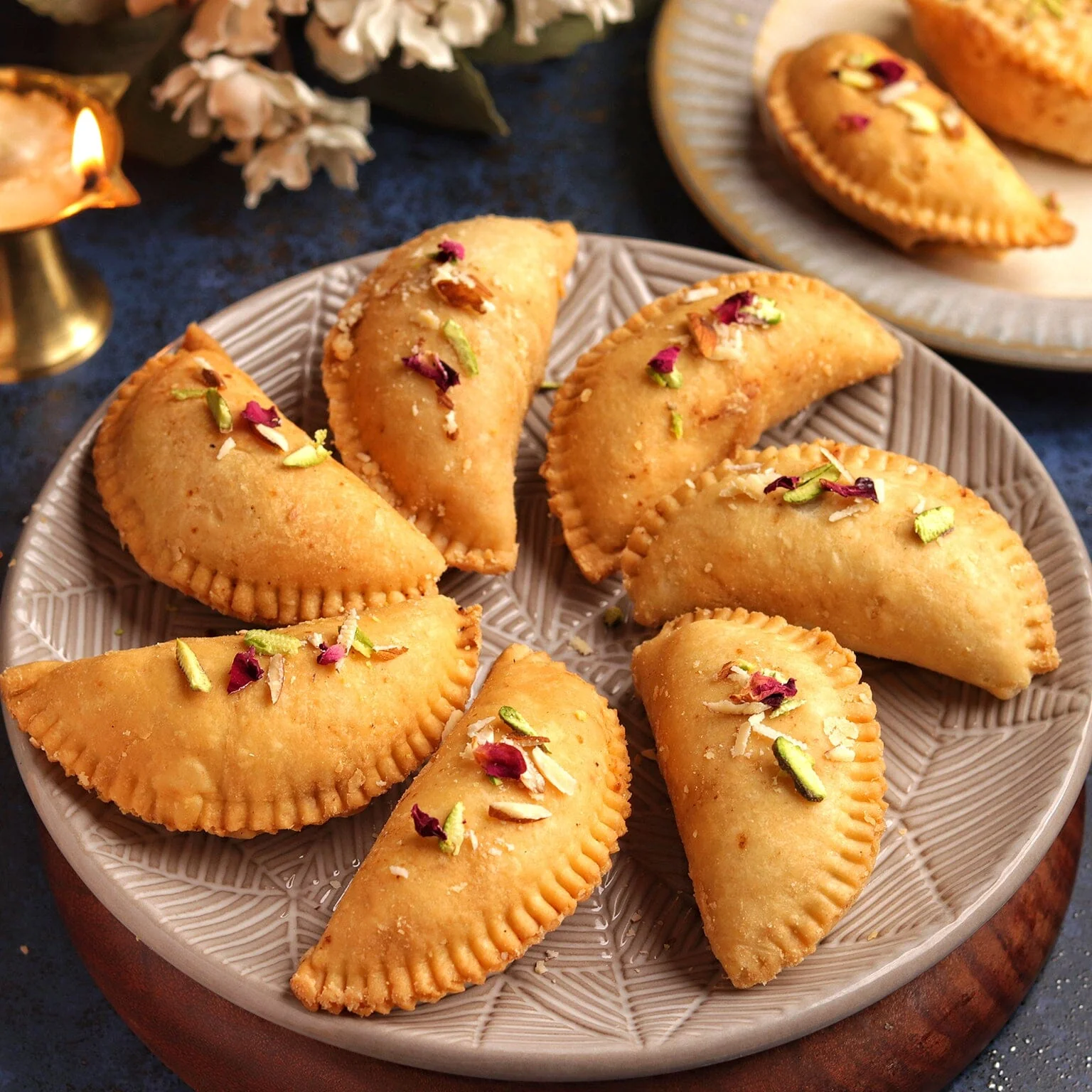As the vibrant festival of Holi approaches, it’s time to indulge in the sweet delights of Gujiya, a beloved North Indian treat that adds a touch of joy to every celebration. With its crispy pastry shell and luscious filling of khoya and nuts, Gujiya holds a special place in the hearts of many, evoking fond memories of festive gatherings and joyful moments shared with loved ones.
In this special Holi 2024 recipe, we’ll explore how to make Gujiya in both the traditional fried and healthier baked versions, offering you the flexibility to enjoy this delightful treat according to your preference. From preparing the pastry dough to assembling the Gujiya and finally frying or baking them to golden perfection, each step is filled with love and tradition, making it a truly memorable culinary experience.
So, gather your ingredients, roll up your sleeves, and let’s embark on a flavorful journey to create the perfect Gujiya that will add a touch of sweetness to your Holi celebrations and bring smiles to the faces of those you love.
What is Gujiya:
Gujiya is a beloved North Indian sweet delicacy that holds a special place in the hearts of many. These delightful pastries are characterized by their crisp and flaky pastry shell, which encases a luscious filling of khoya (milk solids) and assorted nuts. Shaped into crescents, gujiya are deep-fried to golden perfection, resulting in a delightful treat that is both indulgent and irresistible. The rich flavors and textures of gujiya make them a popular choice, particularly during festive occasions like Holi, where they are enjoyed with great enthusiasm across the country.
About Gujiya Recipe:
The traditional gujiya recipe embodies the essence of North Indian culinary heritage, showcasing a perfect balance of flavors and textures. The filling, consisting of khoya, sugar, and nuts, brings a rich and creamy sweetness that contrasts beautifully with the crispy pastry shell. In this recipe, a unique blend of whole wheat and all-purpose flour is used to create the pastry dough, adding depth and complexity to the final dish. While gujiya are typically deep-fried to achieve their signature golden hue and crispy exterior, this recipe offers a healthier twist by providing instructions for baking as well. Whether fried or baked, gujiya are guaranteed to delight your taste buds and transport you to a world of sweet indulgence. With this recipe, you can recreate the magic of gujiya in your own kitchen and share the joy of this beloved treat with family and friends, making every occasion a memorable celebration of flavors and traditions.
How to Make Gujiya (Baking Process)
Step 1: Prepare the Pastry Dough
1. In a bowl, combine 1 cup whole wheat flour, 1 cup all-purpose flour, and ¼ teaspoon salt.
2. Heat 2 tablespoons of ghee until melted and pour it over the flours.
3. Use your fingertips to rub the ghee into the flours until it resembles bread crumbs.
4. Gradually add ⅓ to ½ cup water, kneading the mixture into a firm dough.
5. Cover the dough with a damp cloth and set it aside for 30 minutes to rest.
Step 2: Prepare the Stuffing
1. In a pan, cook 1 cup of crumbled or grated khoya in ½ tablespoon melted ghee until it gathers around itself.
2. Allow the khoya to cool completely, then mix in ⅓ cup powdered sugar, chopped nuts, raisins, and cardamom powder.
3. Set the khoya filling aside.
Step 3: Assemble the Gujiya
1. Divide the rested dough into equal portions and roll each portion into a ball.
2. Roll out each ball into a small circle on a lightly floured surface.
3. Moisten the edges of the circle with water.
4. Place a spoonful of the khoya filling on one half of the circle.
5. Fold the other half over the filling to form a semi-circle and press the edges to seal.
6. Use a fork or gujiya mold to crimp the edges for decoration.
Step 4: Baking
1. Preheat the oven to 200°C (390°F).
2. Place the assembled gujiya on a baking tray lined with parchment paper.
3. Brush the gujiya with oil or ghee.
4. Bake in the preheated oven for 20-30 minutes or until golden brown.
5. Once baked, remove from the oven and allow them to cool on a wire rack.
How to Make Gujiya (Frying Process)
Step 1: Prepare the Pastry Dough
1. In a bowl, combine 1 cup whole wheat flour, 1 cup all-purpose flour, and ¼ teaspoon salt.
2. Heat 2 tablespoons of ghee until melted and pour it over the flours.
3. Use your fingertips to rub the ghee into the flours until it resembles bread crumbs.
4. Gradually add ⅓ to ½ cup water, kneading the mixture into a firm dough.
5. Cover the dough with a damp cloth and set it aside for 30 minutes to rest.
Step 2: Prepare the Stuffing
1. In a pan, cook 1 cup of crumbled or grated khoya in ½ tablespoon melted ghee until it gathers around itself.
2. Allow the khoya to cool completely, then mix in ⅓ cup powdered sugar, chopped nuts, raisins, and cardamom powder.
3. Set the khoya filling aside.
Step 3: Assemble the Gujiya
1. Divide the rested dough into equal portions and roll each portion into a ball.
2. Roll out each ball into a small circle on a lightly floured surface.
3. Moisten the edges of the circle with water.
4. Place a spoonful of the khoya filling on one half of the circle.
5. Fold the other half over the filling to form a semi-circle and press the edges to seal.
6. Use a fork or gujiya mold to crimp the edges for decoration.
Step 4: Frying
1. Heat oil for deep frying in a heavy-bottomed pan or kadai over medium heat.
2. Once the oil is hot, gently slide the assembled gujiya into the hot oil.
3. Fry the gujiya until they turn golden brown and crispy on both sides.
4. Using a slotted spoon, remove the fried gujiya from the oil and drain them on paper towels to remove excess oil.
5. Allow the fried gujiya to cool slightly before serving.
By following these separate processes for baking and frying, you can enjoy delicious gujiya prepared according to your preference, whether you prefer the crispy texture of fried gujiya or the healthier baked version.
Expert Tips for Making Gujiya:
1. Firm Dough: Ensure that the dough is kneaded to a firm consistency. This helps in creating a crisp and flaky pastry shell for the gujiya.
2. Oil Temperature: Maintain medium-hot oil while frying the gujiya to prevent them from becoming greasy. The oil should be heated to the right temperature to achieve perfectly golden and crispy pastries.
3. Even Frying: Fry the gujiya in batches and avoid overcrowding the pan. This ensures that each pastry cooks evenly and attains an even golden color.
4. Proper Sealing: Seal the edges of the gujiya tightly to prevent the filling from leaking out during frying or baking. Proper sealing ensures that the pastries retain their shape and flavor.
5. Experiment with Fillings: Get creative with the fillings by adding unique ingredients like thandai powder or gulkand (rose preserve). These additions can impart distinctive flavors and elevate the taste of the gujiya.
6. Prevent Dough Drying: Keep the dough covered with a moist cloth while working with small batches to prevent it from drying out. This ensures that the pastry remains pliable and easy to work with.
7. Consistent Size: Roll out the dough into circles of uniform size to ensure that all gujiya have the same amount of filling. Consistency in size helps in even cooking and uniform appearance.
8. Trimming Edges: If baking the gujiya, trim the edges with a pastry cutter for a neat and uniform appearance. This step adds a professional touch to the pastries and enhances their visual appeal.
9. Cooling Before Serving: Allow the fried or baked gujiya to cool slightly before serving. This allows the pastry to firm up and the filling to set, enhancing the overall texture and flavor.
10. Storage: Store the leftover gujiya in an airtight container at room temperature or in the refrigerator, depending on the climate. Proper storage helps in maintaining the freshness and crispness of the pastries for longer periods.
Conclusion:
As you savor the delicious flavors of Gujiya, let the spirit of Holi fill your heart with joy and happiness. Whether you choose the crispy goodness of fried Gujiya or the healthier alternative of baked ones, each bite is a reminder of the rich culinary heritage and festive traditions that make Holi truly special.
So, as you share these sweet treats with your family and friends, may your Holi celebrations be filled with laughter, love, and the simple pleasures of life. Here’s to many more joyous moments shared over a plate of homemade Gujiya, making every Holi a memorable and delicious affair.






